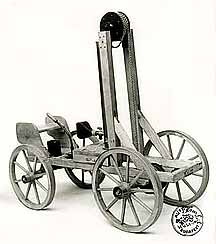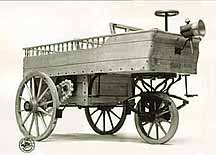History of Hydrogen Cars
Francois Isaac de Rivaz (born in Paris, December 19, 1752; Died in Sion, July 30, 1828) was a Swiss inventor, credited with inventing and constructing the first successful internal combustion engine in 1806. The engine was powered by a mixture of hydrogen and oxygen. A year later, Isaac de Rivaz built one of the first automobiles which are powered by his new engine.

In 1860, Etienne Lenoir of France invented the 1-cylinder, 2-stroke Hippomobile. The Lenoir Hippomobile was so named because it received its fuel by electrolyzing water and running the hydrogen through the small horizontal engine. The Hippomobile engine ran on "natural cycles" with an uptake of fuel mixture and a down stroke combusting the exhausted fuel. Later, Lenoir adapted the engine for various gases such as coal gas. Around 350-400 of the Lenoir gas motors were built and sold.

In 1933, the Norsk Hydro power company converted one of their small trucks to run on hydrogen gas. The Norsk Hydro truck contained an onboard ammonia reformer to extract hydrogen and run it through its internal combustion engine.

The 1941 GAZ-AA truck was created out of necessity by Mr. Boris Shelishch. During WWII, the Nazis had surrounded Leningrad, Russia and cut off supplies. Petroleum was running low. So, military technician Boris Shelishch stepped in an converted a GAZ-AA truck to run on hydrogen gas. After receiving orders from top commanders, Boris Shelishch and his crew were able to convert 200 GAZ-AA trucks in 10 days to run on hydrogen and demonstrated that they burned cleaner and longer than those that had run on petrol

In 1966, Roger Billings used a Model A Ford donated by his father and converted it to run on hydrogen. Two compressed hydrogen cylinders where in the back of the vehicle and since the vehicle's engine had an L-shaped head backfiring was not a problem. Billings used the Model A as part of a high school science fair project.

In 1970, the K. Kordesch passenger car was built by Karl Kordesch and was based upon an Austin A 40. The K. Kordesch was a fuel cell hybrid car using seven lead acid batteries and a 6 kw Union Carbide alkaline fuel cell powered by hydrogen gas. Compressed hydrogen gas was contained in six tanks strapped to the top of the car and the K. Kordesch ran on public roads for three years. The total power output for the K. Kordesch was 150 kw making it comparable to other cars on the road at that time.

In 1972, the Brigham Young Superbeetle, developed by Roger Billings team, won first place for emissions in the Urban Vehicle Design Competition in Ann Arbor, Michigan. Using the water induction method to reduce nitric oxide the hydrogen-powered Volkswagen actually cleaned the ambient air and was given a negative number

In 1976, Roger Billings Provo-Orem bus demonstrated the power of metal hydride storage of hydrogen. the higher weights of the storage vessels and that even in stop and go driving conditions the vehicle was 80-percent more efficient that gasoline-powered vehicles.

In 1979, the BMW 520h is a four-door passenger dual fuel vehicle that can run on either gasoline or liquid hydrogen. The BMW 520h used super-insulated cryogenic tanks for the hydrogen and was equipped with a 3.5-liter direct injection engine.

In 1984, the Mercedes Daimler Benz TN 310 Van was demonstrated in Berlin, Germany. The 10-passenger Mercedes Daimler Benz TN 310 Van uses an internal combustion engine with compressed hydrogen to deliver 75 kw at 5600 rpm. The TN 310 also uses metal hydride storage.
